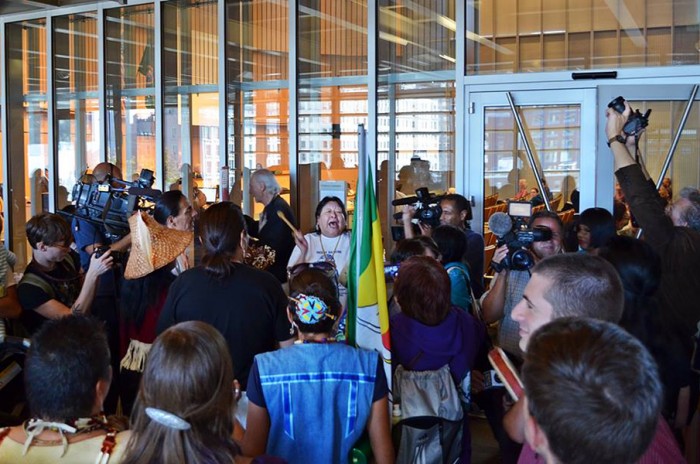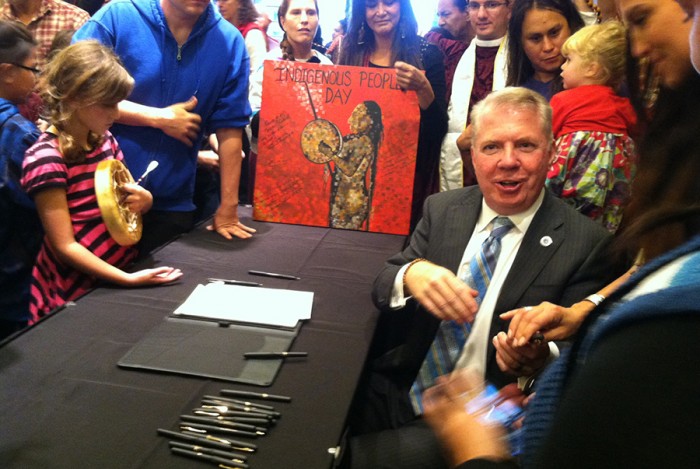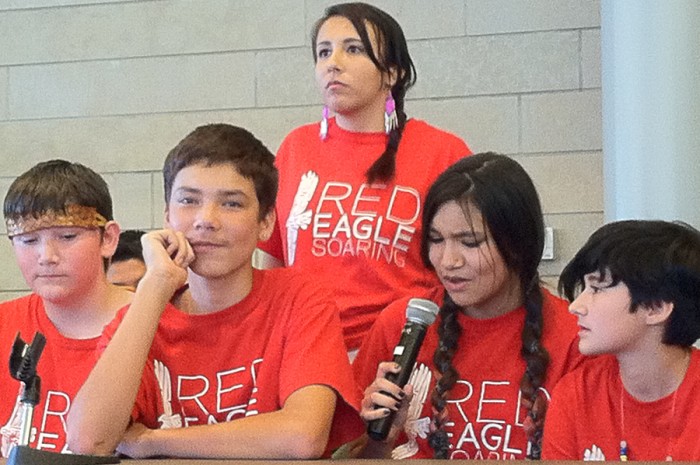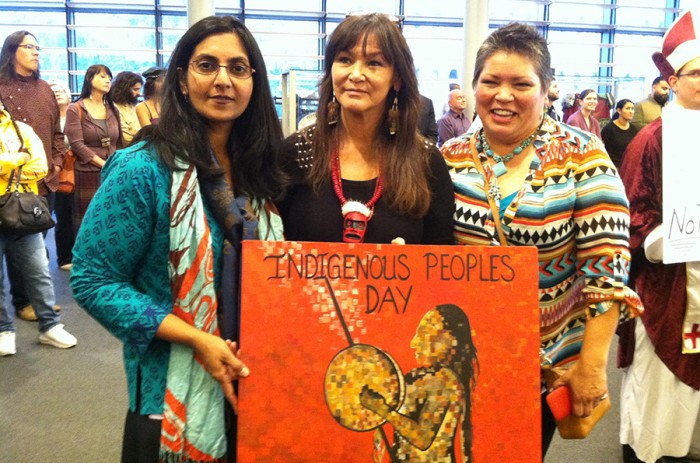
Last Monday’s unanimous city council vote approving Seattle’s Indigenous People’s Day resolution garnered national attention and inspired several other cities, including Tacoma, Bellingham, Lynnwood, Detroit, San Antonio and Portland, to consider replacing Christopher Columbus Day with an Indigenous People’s Day.
Last night, the day became official with Mayor Ed Murray signing the Indigenous People’s Day Resolution into Seattle history, just one of a few gains that our city’s First People could be seeing in the next few years.
“I hope that today is simply not just a day of recognition, but also a moment of healing,” Murray said to a captive audience of about 150 tonight at Seattle City Hall, which included leadership and representation from the Lakota, Tlingit, Haida, Lummi, Puyallup, Tulalip, Duwamish, Suquamish, Snohomish, Swinomish, Yakama and Muckleshoot tribal groups.
They were all there to celebrate the signing of their resolution, something its drafters had been working on passing since 2011 after the Affiliated Tribes of Northwest Indians adopted their own Indigenous People’s Day.

Along with honoring Seattle’s First People at the waterfront with public art, Mayor Murray announced at the signing the reinstatement of a Seattle Indian Commission to support the city’s urban indigenous residents. He appointed former state senator Claudia Kauffman to lead the commission. The original Seattle Indian Services Commission, formed in 1972, dissolved in 2012 due to financial problems.
For longtime community activists like Renée Róman Nose, who is Cheyenne and Arapaho, rebuilding the commission could offer urban tribal communities strength at a critical moment.
“We’ve had a lot of loss in Seattle: the John T. William shooting, the Jack Keewatinawin shooting,” she said. “The establishment of this commission, I hope, will help bring a sense of community, which is badly needed in Seattle for the Native people. Instead of feeling like targets, we’re going to feel like neighbors, which is what we are.”
Beyond establishing Indigenous People’s Day, Section III of the resolution called on Seattle Public Schools (SPS) to adopt “the teaching of the history, culture and government of the indigenous peoples of our state” — something that in previous years, had been met with sharp resistance.
After a nudge from the Seattle Human Rights Commission, back on October 1st, the Seattle School Board also voted to approve observing Indigenous People’s Day and teaching more Native history.
Both wins — the resolution and the future adoption of new curriculum — have been a long time coming, said Matt Remle, Indigenous People’s Day organizer who also staffs the Office of Indian Education of Tulalip in Marysville.
“There’s been so much joy, and so much happiness, that it’s just been beautiful to see and experience.”

Remle said some of the tribal elders he has been working with are in their 60s and 70s, and have been waiting for a moment like this their whole lives.
“You know, it’s like an uplifting moment for our community, so part of the moving forward on a practical level is ensuring SPS … actually follows through with the commitment now,” said Remle.
Advocates are pushing for Since Time Immemorial (STI) curriculum, education guidelines established by 2005’s House Bill 1495, which provides a framework and understanding of tribal history and sovereignty.
Tracy Rector, resolution committee member and executive director of Longhouse Media, pointed to further work on a national level, if not at the federal level.
“We are only the second major city to get this changed,” she noted.
Berkeley began celebrating Indigenous People’s Day in 1992, but Minneapolis became the first U.S. city to adopt the new holiday last spring. Last week, the Portland School Board unanimously voted to celebrate Indigenous People’s Day in schools on the second Monday of October.
Hours after Mayor Murray signed Seattle’s resolution, Bellingham passed their Coast Salish Day Resolution.
“We are hoping to impact other major cities,” said Rector.
It’s part of the committee’s greater strategy of calling attention locally to the issue of renaming Columbus Day, then city by city, since, in past years, going straight to the federal level hasn’t yielded any significant response, Remle explained.
After Seattle’s Indigenous People’s Day campaign gained more visibility in late-August, Remle started getting phone calls from Detroit and San Antonio activists seeking consultation on drafting their own resolution.

At the signing, city council member Kshama Sawant, who co-sponsored the Indigenous People’s Day Resolution with council member Bruce Harrell, applauded activists for correcting an injustice, and illuminating more of it.
“Hands go to all the community members, indigenous and otherwise, who have shown such tremendous solidarity for this community,” said Sawant, “to make sure that not only is there an official recording of the pain and suffering of the genocide and the racism inflicted on our communities, but also to use this as a building block for a real conversation on why many of our communities, still to this day, remain marginalized and exploited.“
Róman Nose hopes future generations will remember what adopting Indigenous People’s Day really demonstrates.
“It’s not a good thing to celebrate a man who’s just known for genocide, a man who, in his first 40 years after contact, is responsible for 14 million deaths,” she said. “To have that wrong righted, and to have it change to a day that celebrates people surviving instead of people dying, is just a heartwarming thing. And it’s something that anyone who has taken any little part in it, no matter how small, can take pride in.”
Earlier in the day during a Red Eagle Soaring youth panel at city hall, 14-year-old Della Keahna Uran painted a clear picture of what the future might look like for her and her Native peers. When asked what she would pick if she could choose one community need to direct funding toward, she responded:
“It would be getting the word out about indigenous cultures, letting people know that we’re still here and we live in a very strong community, and that, in years to come, we’ll be a bigger, better and stronger community than we are now.”

